[Trading with price action] - Crypto Academy / S6W2- Homework Post for @reminiscence01
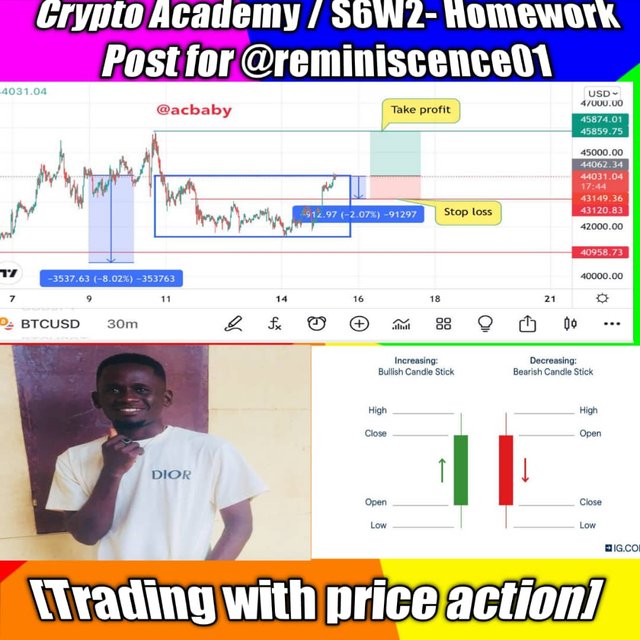


Hello steemians, welcome to my homework task by professor @reminiscence01 which is about “trading with price action”. Here we will discuss what price action is all about and what we can actually gain from this analysis model such that we can make trading cryptocurrencies to become profitable as we stay in the market.


Trading the cryptocurrency markets I’d done by carrying out analysis on the particular asset of interest before investors put their money into the market. Some traders use fundamental analysis as a method of analyzing the market before investing. This is an analytical method that gives an idea about the external forces acting on the price movement of an asset. This is limited by the inability of this model to assign selling when the dumb rate will last for a longer time. This also lacks providing answers to trading psychology of traders in the market, supply and demand rates, and risk management. Due to this loopholes in this analytical model, most traders prefer to use **Price Action” to analyse assets since the above can be provided from the price action model.
Price action provided traders with almost everything needed to stay profitable in the market. The price charts of different assets is a representation of the trading psychology of the traders involved with that asset. This model uses support, resistance, market structures and patterns, trading volume, and technical indicator tools to determine the next market move or price direction such that the trader can place good trades in the preferred direction and be profitable.
The price action is a representation of the emotions and psychology of the traders involved in that asset such that their fear and greed can be seen in the fluctuation of the market price of that asset. Traders using the price action model for analysis apply the price history on the price charts as a preliminary for understanding the future movement of the price. Therefore as repeated patterns have been seen on the price charts, it is assumed that such patterns can only provide certain results such that the trader upon seeing such patterns knows what will happen next. For example, when a double top or double bottom forms it is known that the market will make a trend reversal and from a bearish/bullish market we can have a bullish/bearish market instead. This for sure makes the trader more guaranteed for success.
The price action model of analyzing assets can enable the trader to develop a trading plan such that the trader has a position size and risk management criteria both of which have been studied from past market movements. Therefore the price action gives the trader clues on entry and exit points in the market. For example, using the price action model of analysis you can make a sell entry whenever the price breaks the support and place a take profit point at the next major support while your stop loss is placed at the possible resistance above the breakout point. The opposite goes for a buy signal. This has already provided the trader with a direction and risk management criteria for exiting the market. With all the above ways the trader gets an edge over the market to avoid liquidity from the whales.
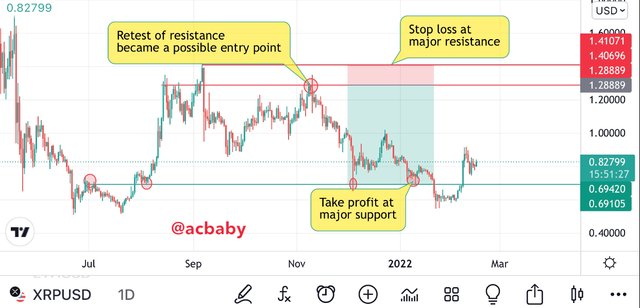
From the above image we can see how the price action model of analysis provides a true clue of which direction to place a trade on and also the size of the position depending on the support and resistance levels. The exit criteria is a good risk management strategy.
Therefore we can say that the fundamentals affect the price of the market but they can’t tell with precision, how much of the market will go north or south whereas the price action gives detail information about the asset price change and also credits it with the risk management criteria as seen from past chart history. It is required that price action model traders pay good attention to the fundamentals so that they grab a clue about what is going to affect the market price before they know through price action what is really good at changing in their market. While price action gives a determination of what change is taking place, a preliminary knowledge from external factors render’s more credit to a price action trader.Trading the b


The importance of price action comes with a lot of added value to analysis carried using this model. When using the price action model there’s more confidence in the trader than can be when working on a different analysis model. Reasons for the importance of the price action model of trading analysis are given below in different points.
Like I said in the previous section, price action describes the trading psychology of various traders investing in a particular asset at a time and also their emotions about the market movement is represented on the price chart. Chart patterns form inky as a result of the manifestation of certain buying and selling pressure activities done by the different traders in the market. A trader is able to understand the emotions of other traders via price action and become able to predict the next possible market move. For example, the case of a double top or bottom means that traders sell/buy at a certain extent a fraction takes profit while others missed the opportunity and in return the silent trades wait for the price to trade to that previous level so that they can take their own profits hence when the price is reached, we have an impulsive reversal move due to liquidity. This is a very common market psychology that happens the same way all the time in the market.
Price action can also enable a trader to understand the current structure of the market (that is whether the market is in an uptrend, downtrend, or in a range) by simply looking at the price chart. Being able to identify the market direction is already a plus in trading the market. With price action analysis it’s a basic thing to be able to understand the current market structure as well as provide signals from the chart when the is to be a reversal or structure slow down such that a continuation follows. With such knowledge, predicting what will happen as a next market move is not too difficult.
Due to the manipulation of the market by big investors, it’s easy for small retail investors to identify which signal or information about a pump or dumb is valid and to what extent is that predicted move valid. The price action model is capable of identifying real signals from false signals such that it filters false signals and provides real information about the true future events and the extent of the event. This is done by the use of some indicators. These indicators used on the price chart alone may yield to giving true and false signals and to cancel this out, traders apply more than one of these indicators on the price chart in order to use one as filter for the other. This makes it easy to filter false signals from the market using price action. Also, the indicators settings or pattern criteria of occurrence provides the trader with conditions or settings for a true signal. Noise from the market are confusing to traders and without them, trading is made better. One of the main price action criteria of noise filtering is by applying the multi-timeframe analysis.
The above described importance of price action model of carrying out trading analysis are very vital to the profitability of a trader hence the importance of this trading analysis model to a retail trader.
Therefore as a retail trader I will choose price action over fundamentals and this will go especially for old assets but I can do more of the fundamentals for newly listed projects since their market movements can only be predominantly predicted using the fundamental analysis. Notwithstanding, applying the fundamentals to complement my first choice (price action) is of vital importance. This is to conclude that I prefer price action over any analysis model due to its importance to a retail trader and the advantages that comes with using price action for analysis.


Different price charts type exist in the trading platforms and each price chart comes with it’s possible analytical analysis that can be carried on it. The Japanese candlestick chart happens to be one of the famous chart types that is widely used by many traders to infer from the price action of the market. On these charts are the graphical expressions of price movement such that where there’s high demand the price values of an asset rises and where there’s low demand and high supply the price value reduces. All of these plays on the price charts such that there’s a continuous up and down moving of the price of an asset over time.
The different types of price charts are : the candlestick chart, line chart, bar chart, hollow chart, heikin ashi chart and others. Each chart system has a way of running analysis on. Due to the advantages of the candlestick in showing the supply and demand control of the market in every significant aspect, it’s considered as the best for analysis of price action.
On the Japanese price chart we can see this movement in smaller segments known as candlesticks which describes the market pressure at every given time. Therefore a single candle tells a lot to a trader. Candles are formed depending on the time frame. Therefore I’m a 5 minutes time frame we have a single candlestick forming completely in 5 minutes while on a higher or lower time frame a candlestick will still form in the complete time lag of that time frame.
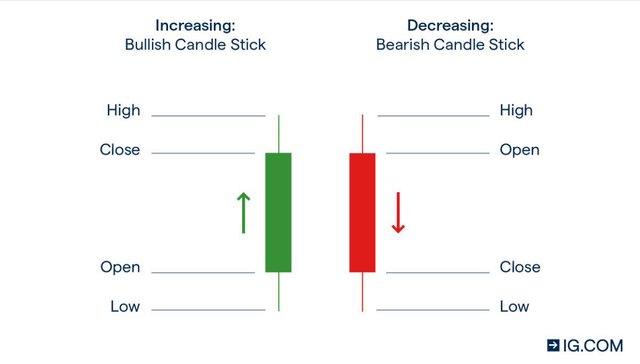
The above screenshot shows the anatomy of a candlestick, this has been described for bothe bearish and bullish candlesticks with the bullish candlestick in green and the bearish candlestick in red. These colours tell a trader if the market value of an asset increases or decreases during the formation of a candlestick.
The bullish nature of a candlestick reflects that the market value of an asset ended higher than it began writing the specific time frame. So if we say 5 minutes, the price started somewhere lower during the 5 minutes and closed higher than it started. Only with such information especially in a higher time frame a trader can tell if the price is bullish or bearish.
Looking closely at the Antony of the candlestick still provides much information to a trader concerning the market within the specific time frame. The candlestick has a full body with some wicks at the ends for some candlesticks. This therefore makes every candlestick unique in describing the buying and selling pressure of the market. The longer the body of a candlestick the stronger the momentum of the direction of the market to which the candlestick belongs. For example, a full body green candle means that the price started at a low price and just went up straight to a higher level indicating a strong buying pressure in the market.
This leaves the candlesticks as strong indicators for the price action of the market. On candlesticks charts we can see support and resistance levels very clearly. If on a support level we see a bullish engulfing candle, we have a bullish signal and if in a resistance area we see a bearish engulfing candle then we have a bearish signal. As simple as this we can use the candlestick chart as a good means to interpret and read the price action activity over different time frames.
For all these advantages of the candlestick chart and it’s patterns applicable in analyzing the market I think I prefer the candlestick over any other chart. The smallest significant information can be gotten from these charts as well as major information can be extracted from the chart. Candlestick charts over the other chart types.


The multi-timeframe analysis like I said above is a technique that we can use to cancel out noise in the market as well as we can now use it to make precisions in support and resistance level such that we can place a good exit criteria for every trade entry we make in the market.
Therefore to prevent losing the right paths or points of focus when it comes to trade set up of key areas such as the resistance and support, we have to employ the multi-timeframe analytical technique because the support and resistance also comment on the risk management criteria upon setting exit points.
The multi-timeframe analysis is done by checking into different timeframes of a particular trading pair such that we can identify the different supports and resistance within these timeframes. The higher time frames are used for market trend identification while the smaller time frames are used to make entries to provide tighter stop loss points. The reasons for the multi-timeframe analysis are well described below.
The muleti-timeframe analysis technique gives a great deal in recognizing hidden support and resistance levels as well as trend identification when prices seems to be difficult to identify the particular trend in a specific time frame.
The multi-timeframe analysis helps to reduce the complexity in the market that comes from too much noise from irrelevant moves in the market. This technique will help to avoid focusing on such positions on the market. Sometimes candlesticks forms without giving a direct pattern to which they collectively belong. In such cases we can apply the multi-timeframe analysis to be able to identify the true trend to which the candlesticks belong.
Multi-timeframe analysis plays a vital role in trading analysis using price action. As it’s importance can be seen above, it’s good that the multi-timeframe technique be practiced with utmost care in order not to loss opportunities in the market all in the name of not being able to understand a trend due to chart complexity on one time frame. The filter capacity of this analysis technique improves signals and points of support and resistance which are a basic tool for exit criteria of most trade set ups.
Time frames used will depend on the trade type to apply. For example, for an intraday trader, the 30min, 15min, and 5min time frames can be used for the multi-timeframe analysis to get the best of intraday trade opportunities.


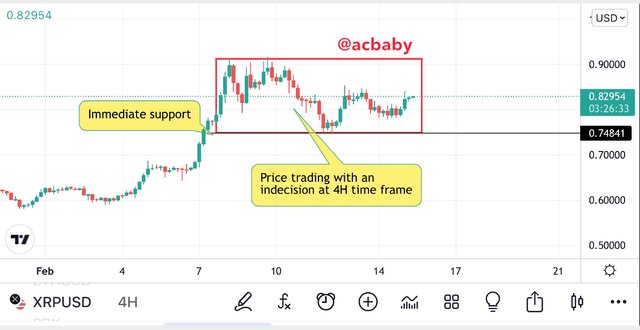
As seen from the above screenshot for XRPUSD pair, unless the time frame is changed to a higher time frame, the direction can not be easily recognized from the chart. So in this case we can switch to a Daily timeframe and this noise will be canceled out leaving us with a clear idea of the price trend at this very position of the market.
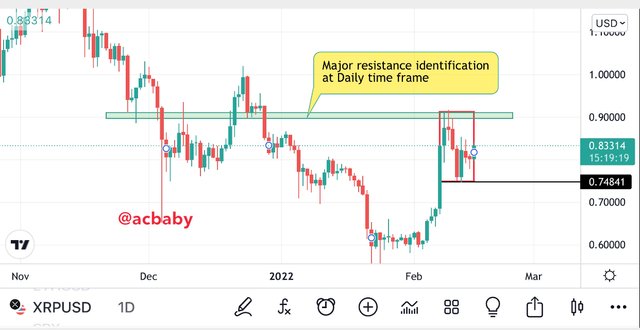
From the screenshot above we can see that the price trend of the same trading pair as above is now very clear on the Daily time frame chart. Even when looked keenly we see price rejection at certain levels which leaves us with resistance dimensions on the chart.
With all the above information obtained from the multi-timeframe analysis we can now place a trades on that particular position of the asset such that it’s no more without direction since the trend has been identified on the Daily time frame chart.
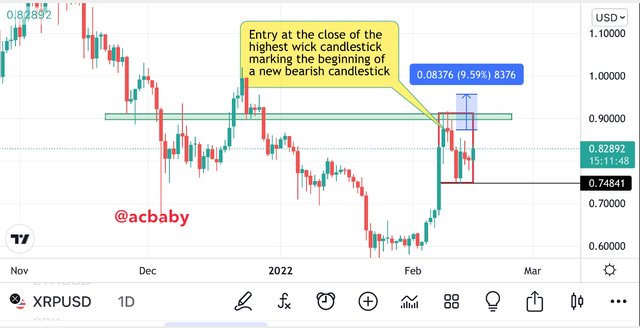
From the above screenshot we make an entry point identification from the close of the highest candlestick that touched the resistance level more than the other and marks the beginning of a new bearish candle. The stop loss will be set just above the resistance level and I have marked the sport with the vertical arrow. Placing or indicating a stop loss at this time frame will make the position to be very large and it needs reduction. Next I will bring the time frame to a lower scale.
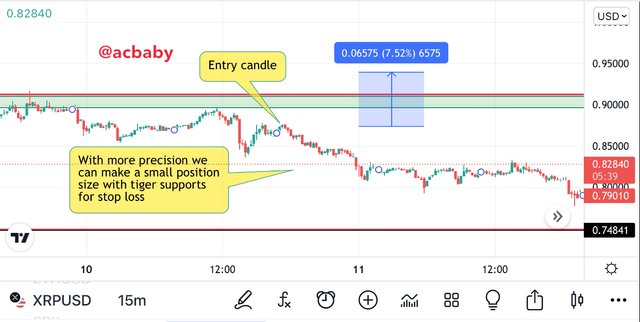
It can be seen on the price chart that making an entry here will have us make a small stop loss level which will make the position size to be normal for a good trade. At such points the stop loss can now be clearly adjusted from smaller resistance close to the major resistance level. At the 15mins timeframe we can see how clear we get tighter positions for stop loss and take profits such that we can set up different take profit levels on the trade.
The above analysis is a description of the multi-timeframe analysis technique used in reducing noise and giving precision on support and resistance levels for exit criteria of a trade.


Here I will look at the BTCUSD pair and analyse it using the multi-timeframe technique in order to place precise take profit and stop loss using different support and resistance information.
First I identify the current market point of the BTCUSD pair and identify the point of indecision or where the price movement has no direct decision.
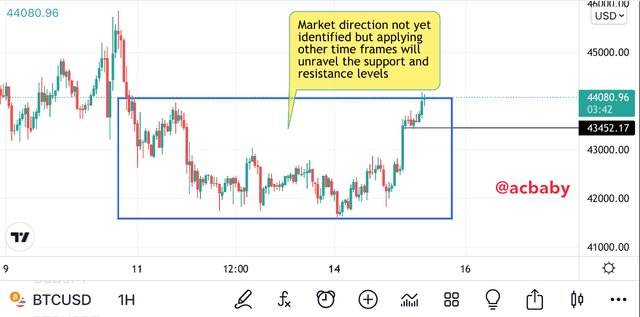
Secondly I will analyse the price chart on a higher time frame and in this case I used the Daily chart so that the main support and resistance can be identified in the market.
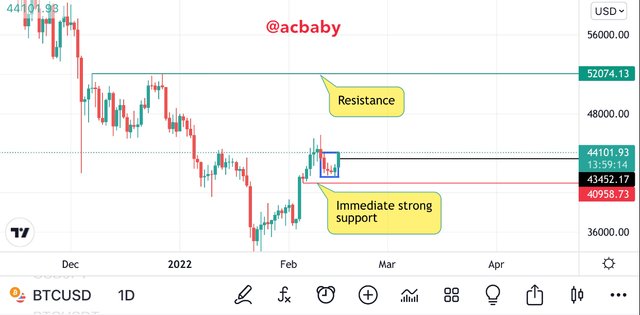
Thirdly, I identified a major support and resistance for a larger position such that the actual position I will make an entry to will fall within the larger position.
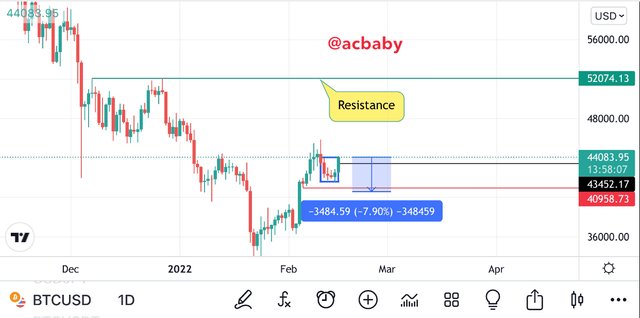
Since in the daily time frame the position size will be too large for a good trade, I will dive into a smaller time frame such as the 30min time frame. This way I can identify a better support and resistance tighter for a good stop loss and take profit points. The first screenshot below shows the 30min chart with the former strong support and resistance such that they form the stop loss and take profit of the large position size.
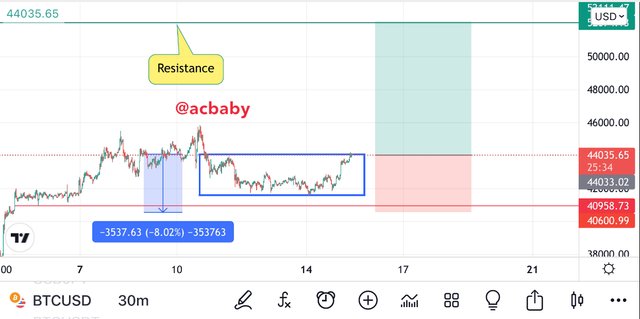
The second screenshot of the 30mins time frame is seen below with tighter support and resistance points taken as the immediate take profit and stop loss.
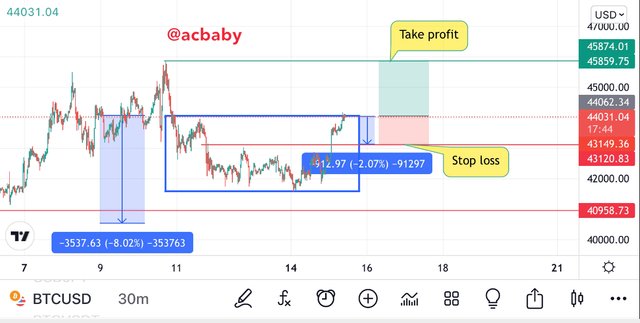
The screenshot below is the proof of trade progress as of a few minutes after entry was made.
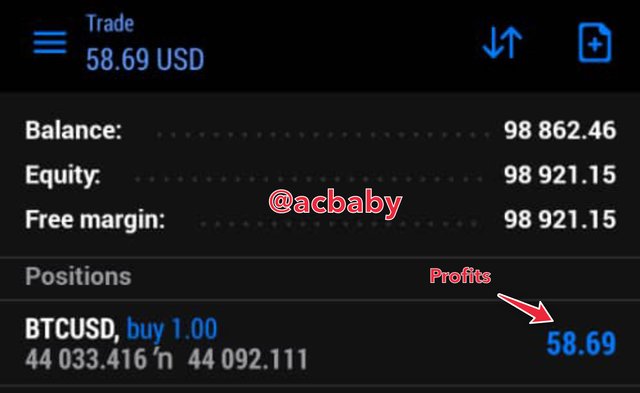


The price action is a major component in trading cryptocurrencies because it’s ability to describes a lot of characters on the price chart at a time. Being able to identify certain activities such as trading psychology and emotions of traders on the price chart makes price action analysis model more credible for a retail trader. Also, to identify complicated trends on the chart we can use the multi-timeframe technique where we can switch time frames to best satisfy the trend identification and also know precise support and resistance levels. With such vital information the trading journey of a cryptocurrency trader can be made profitable.
Thanks for reading my task
Hello @acbaby , I’m glad you participated in the 2nd week Season 6 at the Steemit Crypto Academy.
Unfortunately, our investigation showed that your account is an alternate account to @nackasnelson. Content farming in the academy to earn a reward is not tolerated in the Steemit Crypto Academy. Your account will be blacklisted for violation of this rule.
Remark: Homework Task Disqualified
Okay sir thanks a lot
@reminiscence01 - why are you voting on this post ?!
The post was voted initially for documentation using the scribe tool. That is the only way the tool will detect i have visited the post. But i will remove my vote now.
maybe the professor was just following a trail :D
The homework task was reviewed initially. After i spotted the alternate account of the user, i have to remove my rating and left this comment.
Unfortunately, after our checks and investigations, we found that your account is an alternate account for @nackasnelson. There are similarities in content between users - @nackasnelson & @acbaby.
Operating an alternate account to earn a disproportionate reward is a flagrant violation of Steemit Cryto Academy. Hence, you are now blacklisted.
Thank you.
Cc:@steemcurator01
cc @thegreens @saxopedia
Noted and further sanctions will be taken at the community level. Thanks!
@fombae
@chant
@majerius
@saxopedia
This act is not tolerated on the steemit platform.
Sure, they will be sanction too at community level.
Thanks for bringing it to our attention